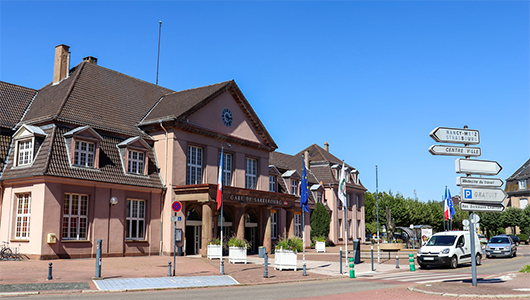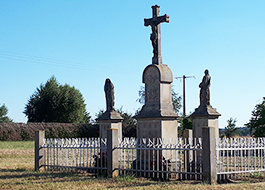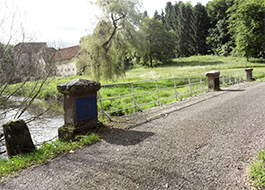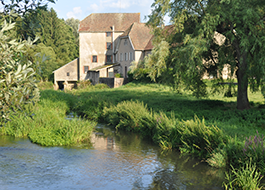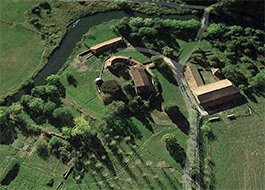Oberstinzel
Durée visite : 50 minutes
Moyen : Pédestre
L’ancienne seigneurie de Sarreck située sur la Sarre appartenait, au XIVe siècle, à l’évêque de Metz et à la puissante famille alsacienne de Lichtenberg. En 1381, les habitants de Sarrebourg détruisirent le château. Au XVIe siècle, la seigneurie relevait de Frédéric de Lutzelbourg, gouverneur de Sarrebourg.
The former lordship of Sarreck on the Saarland belonged in the 14th century to the Bishop of Metz and the powerful Alsatian family of Lichtenberg. In 1381, the inhabitants of Sarrebourg destroyed the castle. In the 16th century, the lordship was the responsibility of Frederick of Lutzelbourg, governor of Sarrebourg.
Die ehemalige Herrschaft von Saarland im Saarland gehörte im 14. Jahrhundert dem Bischof von Metz und der mächtigen elsässischen Familie Lichtenberg. Im Jahr 1381 zerstörten die Bewohner von Saarburg das Schloss. Im 16. Jahrhundert lag die Herrschaft unter Friedrich von Lutzelburg, dem Gouverneur von Saarburg.

Coupé d’azur à la fasce d’argent et de gueules au chevron ployé d’argent.
Il s’agit des armes des anciens seigneurs du lieu : la fasce des Fénétranges, et le chevron ployé de La Petite Pierre.
Cut from azure to the silver fasce and mouths to the silver-folded chevron.
These are the weapons of the ancient lords of the place: the fasce of the Strangers, and the folded chevron of La Petite Pierre.
Ein geschnittener, silberner Chevron mit silbernen Chevron.
Es handelt sich um die Waffen der alten Herren des Ortes: die Fasce der Fénétranges und den chevron ployé von La Petite Pierre.
Les points de visites
.
Un calvaire est une croix sur laquelle est représenté Jésus crucifié. Autour se trouvent plusieurs personnages bibliques : les deux larrons ou leur croix, la Vierge Marie, Saint-Jean. Les plus beaux sont les calvaires bretons qui sont de grandes œuvres sculptées, très travaillées et très bien préservées. Celui-ci, avec la Vierge et Marie-Madeleine, les égale.
An ordeal is a cross on which Jesus crucified is depicted. Around them are several biblical characters: the two larrons or their cross, the Virgin Mary, St. John. The most beautiful are the Breton ordeals which are great sculpted works, very worked and very well preserved. This one, together with the Virgin and Mary Magdalene, equals them.
Ein Martyrium ist ein Kreuz, auf dem der gekreuzigte Jesus dargestellt wird. Drumherum gibt es mehrere biblische Figuren: die beiden Diebe oder ihr Kreuz, die Jungfrau Maria, St. Johannes und so weiter. Die schönsten sind die bretonischen Kalvarienberge, die große geschnitzte, sehr bearbeitete und sehr gut erhaltene Werke sind. Dieser, mit der Jungfrau Maria und Maria Magdalena, ist ihnen ebenbürtig.
.
.
Il fait référence au combats menés ici le 20 novembre 1944, par la 2e DB. Les hommes de Leclerc doivent s’ouvrir le chemin vers l’Alsace. Le lieutenant-colonel Rouvillois est nommé à la tête du 12e Cuirs, alors intégré à la 2e DB, le 11 novembre 1944. Le sous-groupement Rouvillois fonce à partir de 14 heures droit au Nord par des petits chemins. Il détruit les résistances allemandes, fait des hécatombes et réussit à s’emparer à Oberstinzel du pont sur la Sarre, au moment même où l’artificier allemand allait le faire sauter. La progression reprend à allure de course. Au soir le détachement de tête fait irruption et s’installe dans le gros bourg et carrefour routier de Rauwiller. Toute la nuit des véhicules allemands, ignorant la présence française, viendront s’empiler, détruits, aux quatre entrées du village. Le col de la Petite Pierre est atteint le lendemain. Le 23 Novembre, Rouvillois et son unité entrent les premiers à Strasbourg.
It refers to the fighting waged here on November 20, 1944, by the 2nd DB. Leclerc’s men must open their way to Alsace. Lieutenant-Colonel Rouvillois was appointed head of the 12th Leather, then integrated into the 2nd DB, on 11 November 1944. The Rouvillois subgroup runs from 2 p.m. straight north by small paths. He destroyed the German resistance, made hecatombs and managed to seize Oberstinzel from the bridge over the Saarland, just as the German artificer was about to blow it up. The progression resumes at the race pace. In the evening the head detachment burst in and settled in the big town and road junction of Rauwiller. All night German vehicles, ignoring the French presence, will pile up, destroyed, at the four entrances to the village. The Pass of the Little Stone is reached the next day. On 23 November, Rouvillois and his unit entered Strasbourg first.
Er bezieht sich auf die Kämpfe, die hier am 20. November 1944 von der 2. DB geführt wurden. Die Männer von Leclerc müssen sich den Weg ins Elsass bahnen. Oberstleutnant Rouvillois wurde zum Leiter des 12. Leders ernannt, das am 11. November 1944 in die 2. DB aufgenommen wurde. Die Untergruppierung Rouvillois rast ab 14 Uhr auf kleinen Wegen nach Norden. Er zerstörte die deutschen Widerstände, machte Massaker und schaffte es, oberstinzel die Brücke über das Saarland zu erobern, genau zu der Zeit, als der deutsche Bombenbauer ihn in die Luft sprengte. Der Vormarsch nimmt wieder zu. Am Abend stürmte die Kopfabordnung in die große Ortschaft und Straßenkreuzung Rauwiller. Die ganze Nacht werden deutsche Fahrzeuge, die die französische Präsenz nicht kennen, sich zerstört an den vier Eingängen des Dorfes stapeln. Der Col de la Petite Pierre wird am nächsten Tag erreicht. Am 23. November kommen Rouvillois und seine Einheit als erste nach Straßburg.
.
Ce moulin sur la Sarre n’est plus en service. Plusieurs productions pouvaient avoir recours à un moulin hydraulique : les meules à farine ou à huile mais aussi des foulons, des installations qui travaillent des végétaux, fibres pour tissus ou papier, ou bien des métaux. Les activités de broyage de matière peuvent être dangereuses, du fait de la plus grande inflammabilité des poussières ou matières finement divisées à l’air. Aussi les moulins ont-ils été placés à distance respectable des habitations, étables et réserves de nourriture.
This mill on the Saarland is no longer in use. Several productions could use a hydraulic mill: flour or oil millstones but also treads, plants, fibers for fabrics or paper, or metals. Material grinding activities can be hazardous due to the greater flammability of finely divided dust or materials in the air. As a result, the mills were placed at a respectable distance from homes, stables and food reserves.
Diese Mühle am Saarland ist nicht mehr in Betrieb. Mehrere Produktionen konnten auf eine Wassermühle zurückgreifen: Mehl- oder Ölmühlsteine, aber auch Schläuchen, Anlagen, die Pflanzen, Gewebefasern oder Papier bearbeiten, oder Metalle. Material zerkleinern kann gefährlich sein, da fein in die Luft gespaltene Stäube oder Materialien besser entflammbar sind. Daher wurden die Mühlen in einer respektablen Entfernung zu den Häusern, Ställen und Vorräten von Lebensmitteln platziert.
.
Le château du Sarreck à Oberstinzel, avec son plan circulaire, témoigne d’éléments fortifiés, représentatifs d’une architecture militaire. A l’aube du XVIe siècle, le climat de querelles, de luttes d’influences et de guerres qui régnait alors sur l’ensemble du territoire actuel de la Moselle, nourri par le manque d’unité politique, n’était pas propice à l’essor des châteaux d’habitation. Même au moment où la Renaissance s’épanouit, l’architecture garde des éléments défensifs. Une ruine sur une hauteur indiquerait l’emplacement du château primitif, attesté au début du XIVe siècle. En 1381 il appartenait au comte Henri de la Petite-Pierre, brûlé et détruit par les Sarrebourgeois. Le nouveau château fut reconstruit au XVIe, partiellement détruit durant la guerre de Trente Ans, restauré au XVIIIe siècle par le baron de Bande. Vendu comme bien national, propriétaire actuel les descendants d’Alexandre Hertz notaire et conseiller général à Sarrebourg. Le plus illustre propriétaire fut le général Adam Philippe de Custine commandant de l’armée du Rhin, guillotiné en 1793. La tour-porche date du XVIe siècle.
The Sarreck Castle in Oberstinzel, with its circular plan, testifies to fortified elements, representative of a military architecture. At the dawn of the 16th century, the climate of quarrels, struggles of influence and wars that prevailed over the entire territory of the Moselle at the time, feed by the lack of political unity, was not conducive to the development of the castles of residence. Even at a time when the Renaissance flourished, architecture retained defensive elements. A ruin on a height would indicate the location of the primitive castle, attested at the beginning of the 14th century. In 1381 it belonged to Count Henri de la Petite-Pierre, burned and destroyed by the Sarrebourgs. The new castle was rebuilt in the 16th century, partially destroyed during the Thirty Years’ War, restored in the 18th century by the Baron de Bande. Sold as a national property, current owner the descendants of Alexandre Hertz notary and general councillor in Sarrebourg. The most illustrious owner was General Adam Philippe de Custine, commander of the Rhine Army, guillotined in 1793. The porch tower dates back to the 16th century.
Das Schloss Saarbrücken in Oberstinzel mit seinem runden Plan zeugt von befestigten Elementen, die für eine militärische Architektur repräsentativ sind. Zu Beginn des 16. Jahrhunderts war das damals über das gesamte Gebiet der Mosel herrschende Klima des Streits, des Einflusses und der Kriege, durch das Fehlen von politischer Einheit nährt, nicht förderlich für den Aufschwung der Wohnburgen. Selbst in der Zeit, in der die Renaissance aufblüht, bewahrt die Architektur defensive Elemente. Eine Ruine auf einer Höhe würde die Lage des ursprünglichen Schlosses zeigen, das anfang des 14. Jahrhunderts bezeugt wurde. 1381 gehörte er dem Grafen Henri de la Petite-Pierre, der von den Saarburgern verbrannt und zerstört wurde. Das neue Schloss wurde im 16. Jahrhundert wieder aufgebaut, während des Dreißigjährigen Krieges teilweise zerstört und im 18. Jahrhundert vom Baron de Bande restauriert. Verkauft als Nationalgut, derzeitiger Besitzer der Nachkommen von Alexandre Hertz Notar und Generalrat in Saarburg. Der berühmteste Besitzer war General Adam Philippe de Custine Kommandant der Rheinarmee, guillotiniert im Jahr 1793. Der Torturm stammt aus dem 16. Jahrhundert.

